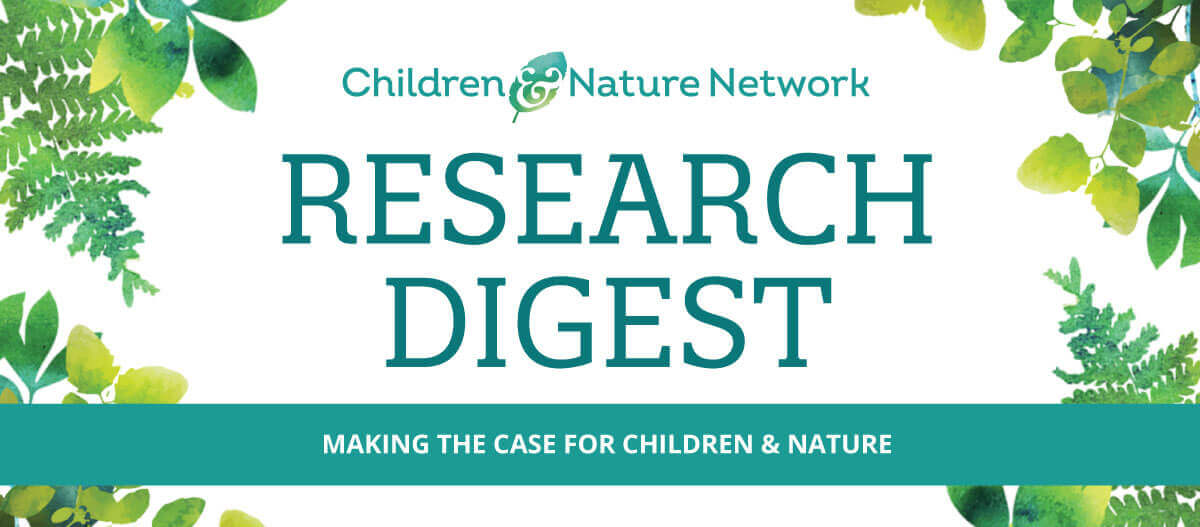GREEN LIVING ENVIRONMENT
Exposure to greenspace during childhood has been associated with a wide range of both short-term and long-term health benefits. The studies in this section of the Digest focus on passive exposure to greenness at home, at school or in neighborhood environments, or presence of pet(s) in the home.
Exposure to greenspace early in life could result in beneficial structural changes in the brain
This study utilized data on 253 urban children (age 7-10) in Spain. The data included a satellite-generated estimate of the children’s lifelong (birth through the time of the study) exposure to residential greenspace and high-resolution 3D magnetic resonance images (MRI) of the children’s brain anatomy. Residential greenery was positively linked to tissue volume in various areas of the brain that are associated with cognitive functions – like attention and memory – that have been shown to be impacted by nature exposure.
Dadvand et al., 2018. The association between lifelong greenspace exposure and 3-dimensional brain magnetic resonance imaging in Barcelona schoolchildren.
Mitochondria readings in primary children suggest that more green space during early life might promote health in later life
This study linked the results of over 400 buccal (cheek) cell swabs collected from 246 children (age 9-12) in Belgium with the level of greenness surrounding each child’s home and the distance from the child’s home to public green space. The results showed that more green space was associated with a higher mitochondrial DNA content (mtDNAc) for urban children, although the opposite was true for agricultural children. Results also showed a higher mtDNAc for children living closer to green space. Higher mtDNAc during childhood may suggest better adult health.
Hautekiet et al., 2022. Higher buccal mtDNA content is associated with residential surrounding green in a panel study of primary school children.
Access Study
Greenspace exposure and telomere length are positively linked in preschool children
Blood samples from 200 preschool children (age 5-7) in Iran were analyzed for leukocyte telomere length (LTL), which is considered to be a marker of aging. The shortening of telomeres suggests a higher risk of developing adverse health outcomes. Blood samples were linked to four different measures of greenspace exposure for each child. Results generally showed positive links between LTL and more exposure to greenspace.
Miri et al., 2020. Association of greenspace exposure with telomere length in preschool children.
Access Study
Subjective proximity to green spaces might not be associated with lower blood pressure in children
Data for this study was based on parent and child questionnaires and blood pressure (BP) readings of a large sample (N= 12,340) of Iranian children (age 7-18). Surveys completed by the children provided information about perceived proximity to greenness (green space within a 15-minute walk from home). Results showed reduced BP was associated with subjective proximity to green spaces. This reduction, however, was not statistically significant.
Abbassi et al., 2020. Subjective proximity to green spaces and blood pressure in children and adolescents: The CASPIAN-V study.
Access Study
Greater greenness near schools is associated with lower blood pressure, especially in overweight or obese children
This study included 9,354 children (age 4-17) from 62 schools in seven cities in northeast China. Two satellite-based measures (NDVI and SAVI) were used to assess greenness around the schools. Higher greenness was consistently associated with lower blood pressure in the children and lower levels of air pollution. The beneficial effects of higher greenness were stronger in children with higher BMI (body mass index) levels.
Xiao et al., 2019. Greenness around schools associated with lower risk of hypertension among children: Findings from the Seven Northeastern Cities Study in China.
Access Study
Green space around schools is linked to lower allostatic load in urban children
This study used seven biomarker assessments of 3,108 children (age 7) in Portugal and satellite-based estimates of their access to greenspace around their home and school. Children attending schools with more nearby greenspace exhibited significantly lower allostatic load (AL) scores than children attending schools with less nearby greenspace. No significant associations with AL were observed with accessibility to green space around the home. AL is a measure of biological multi-system dysregulation.
Ribeiro et al., 2019. Association between neighbourhood green space and biological markers in school-aged children. Findings from the Generation XXI birth cohort.
Access Study
Pets can reduce the chances of elevated blood pressure and hypertension in children
Blood pressure (BP) readings on 9,354 children (age 5-17) in China indicated that children with dogs in the home were significantly less likely to have elevated BP and hypertension than children without dogs. These results are consistent with some other studies finding similar outcomes for adults with pets.
Xu et al., 2017. Prenatal and postnatal exposure to pet ownership, blood pressure, and hypertension in children: The Seven Northeastern Cities study.
Access Study





